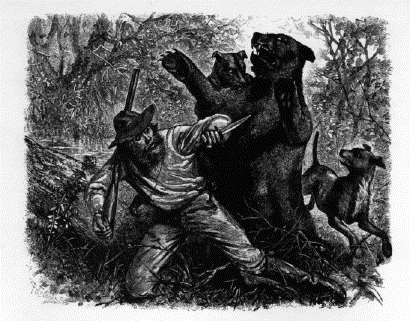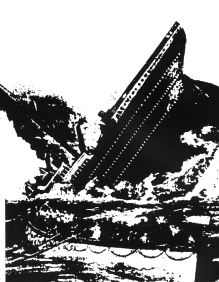Game
Cookery:
The Hunter's
Home Companion
Carol V. Wary
(Countryman Press)
 The "Brunswick Stew Normandy" includes a squirrel, a rabbit, a pheasant, a pound of venison, a half-cup milkweed shoots and one-half cup of brandy. We'd suggest forgetting about all except the latter.
The "Brunswick Stew Normandy" includes a squirrel, a rabbit, a pheasant, a pound of venison, a half-cup milkweed shoots and one-half cup of brandy. We'd suggest forgetting about all except the latter.Ms. Wary, obviously the Pantagruel of Landschaft Küchen, is given to boiling up pheasant, squab, quail, and ruffed grouse --- and as well, bear, elk, caribou, antelope, whole beeves, and, presumably, rhinoscerwassers.
In the Moose Roast, she calls for a four-pound section of moose, but doesn t suggest what to do with the other 796 pounds.
Bear Chili calls for two to three pounds of bear roast, but doesn't mention the 6,000 square foot meat freezer she obviously keeps brimming with humongous Ursus' tums, thighs and tongues. There's no bear-tail stew here, but there are Old English Bear Sandwiches, Venison Cocktail Meatballs, Venison Pot Pie, Antelope Paprikash --- and for those who want to set their sights a little lower --- Pickled Nasturtium Buds.
Her recipes for turkey are notable (she suggests stuffing bacon under the skin to keep the breasts moist and tender, while giving it a smoky flavor; she also cooks it in Vermouth (which might curl all the short hairs out there in the North Forty). Her recipe for Florida Gumbo would have our Great Aunt Rhea spinning about in her grave: Ms. Wary calls for two large wild ducks. Rhea always made do with ten crabs, fifty shrimp, and a bushel of okra. The quackers she served on the side.
Mormon
Murders:
A True Story of
Greed, Forgery,
Deceit, and Death
Steven Naifeh and
Gregory White Smith
(Weidenfeld and Nicholson)
The center of the storm was one Mark Hofmann who, in 1985, blew up several people in an attempt to keep the lid on a very dicey series of forgeries he had produced and marketed to the Mormon Church and some of their most affluent members. Not only is the tale itself a humdinger, equally engrossing are the history of the church, the details of the character of Hofmann, and the tale of his uncanny ability to gull a more-than-paranoid church hierarchy, with its hundreds of experts on documents, church history, and handwriting.
This is how a forged letter from an early Mormon, one Martin Harris, is described:
- If Mary had recorded her version of the Annunciation, if the Apostles had penned letters home about the Last Supper, if the soldier guarding Christ's tomb had written a memoir, that's how important Harris's letter was. Here for the first time was written, first-hand confirmation by Martin Harris of Joseph Smith's First Vision, the golden plates, and, most important, the divine origin of the Book of Mormon.
Hofmann's comet-like rise and fall, (he had access to the highest officials of the Church) came about, the authors explain, because the Mormon Church, more than most, has a history
- already marred with murder, forgery, fraud, boundless lust, betrayal, and power politics --- to say nothing of polygamy. With a history like that, it wasn't surprising that the Church in which Mark Hofmann grew up, was, to put it mildly, ambivalent about its past. Rather than study history, Mormon historians preferred to rewrite it --- or just forget it.
The Mormon Murders would be nothing if it were simply Church-bashing. But the authors show the good with the bad --- and seem to grieve with the real victims of this tale --- that is, the good and faithful Mormons who were had not only by Hofmann, but by the County prosecutor's office (Hofmann was allowed to plea bargain; the case never went to trial), the FBI (which refused to release key documents), the media (church-owned television stations down-played certain key aspects of the case), but most of all, the Church itself.
Despite their alleged close dealings with a convicted forger, felon, and murderer, three of the Mormon "Counselors" --- Hugh Pinnock, Francis Gibbons, and Gordon Hinckley --- went on to high positions of authority.
Looking
For a Street
Charles Willeford
(Countryman Press)
- I was filled with shame. It took all of the courage I could muster to ding a stranger for a dime, a nickel, or anything. Then, after I had accepted the idea that I was a professional road kid --- that begging was what I did --- I didn't let anybody get by me. I asked everyone who came by for something: men, women, children, even the most unlikely prospects. If I was turned down when I asked for money, I asked for a cigarette. If I wasn't given a cigarette, I asked for a match, and failing to get a match, I would ask for directions or the time. It becomes a matter of perverse pride to get something from these strangers, your fellow Americans, even if it is only a curse.
I Was Looking for a Street does have sentiment --- that straight-edged, no frills sentiment that American writers so much favor. It is, nonetheless, a little thin in the insight, wisdom and feeling department.
Blue Lady's
Hands
John Champagne
(Lyle Stuart)
Sailor
W. MacDonald Ryder
(University)
 Prairie Sailor is a superbly written story of an inlander's head-first
dive into the world of ocean sailing. The story takes the reader into
the dockside life of three men who recklessly embark on a 3,000 mile
sailing odyssey from San Diego to Hawaii. The excitement comes from the fact that the three main characters embark haphazardly across the Pacific
Ocean without:
Prairie Sailor is a superbly written story of an inlander's head-first
dive into the world of ocean sailing. The story takes the reader into
the dockside life of three men who recklessly embark on a 3,000 mile
sailing odyssey from San Diego to Hawaii. The excitement comes from the fact that the three main characters embark haphazardly across the Pacific
Ocean without:- A motor
- Money
- Radio
- Wind.
The crew must deal with each other's character flaws as well as the fact that they are lost at sea for what may be a long time, perhaps forever. It's a well-written paraphrasing of the ship's log.
The book claims to be a work of fiction, "Any resemblance..." etc. etc. This is to protect the author from the cousin stowaway who probably has visions of torts dancing in his head.
It would have been a weenie-bit more interesting to this reader had there been a woman stowaway who becomes the First mate of each of the two friends on board. Sex and then some more Sex and then a eenie-bit more Sex is the only thing that could anchor this book to the seafloor bin of the local bookstore.
Imagine, if you will, that if instead of a whining fudge of a cousin if we had a nubile young castaway with the desire to love, and to love to learn, and to learn to love, and to love and learn --- what it means to be on the high seas with two men on a boat called the Sea Nymph. Imagine that if you will. Pant.
However, this book is an honest depiction telling of an unprepared bunch of sailors who lack experience and money enough overcome their own personalities and the Pacific Ocean, and merely survive long enough to write a book about it.
International
Thesaurus
(l977 Edition)
Revised by
Robert L. Chapman
(Harper & Row)
The other day I went to the front of the book rather than to the index of words in the back as I usually do, to find out more about this classic.
Peter Roget was born in England of Swiss parents in l779. He entered the University of Edinburgh at the age of fourteen and graduated from medical schol at nineteen. A physician and lecturer, Roget founded a charity clinic in London and donated his services to it for eighteen years.
His writing during this period included On Vegetable and Plant Physiology, a two volume work on phrenology, and several articles for the Encyclopedia Brittanica.
He played an important role in the establishment of the University of London, and was Secretary of the Royal Society. He devised a slide rule and worked on perfecting a calculating machine. Roget's appointment to head a commission studying London's water supply led to a warning that sewage was polluting the Thames, which was ignored.
His Thesaurus, however, was not ignored. In his lifetime he saw the book go through twenty-eight reprints. It has always been a family affair; Roget's son, Dr. John Roget, continued his father's work, greatly expanding it for an l877 edition. Mr. Thomas Crowell purchased the rights to this edition in l886. His son, T. Irving Crowell, followed in his footsteps and his grandson, Thomas Y. Crowell, is currently the publisher.
Many of the improvements in style and layout, as well as the addition of tens of thousands of new words, are their work.
Roget took the word Thesaurus from the Greek and Latin, meaning storehouse, and described it as a system of verbal classification.
It is a treasure chest containing over 256,000 words with their similar, contrasting and opposing terms, dozens of lists containing words without synonyms and over a thousand large categories of ideas.
What are we to make of the fact that the entry for "cheerfulness" has 19 sub-heads, while "resentment, anger" has 30? Does it enrage, infuriate, madden you? (#23) Make you splenetic, rancorous, virulent? (#24) Does it get your gorge, back, dander or Irish up? (#17) Are you pissed or browned off? Feel like raising hell, the devil or the roof? (#15) PO'd or TO'd? (#26)
If you still cannot quite express your displeasure, there are over a hundred other possibilities without even broaching the other broad categories of "ingratitude" with 5 sub-heads, "ill humor" 30 subheads, "jealousy" 4 subheads, "envy" 4 subheads, or "revenge" 6 subheads.
Think of the treasure hiding beneath the stern heading "resentment, anger." Try reading entry #952 the next time you're resentful or angry, and you'll learn a lot about yourself and your beautiful, rich, underused language. Then look up a favorite word, say "ointment." It can also be called "unction" or "chrism," both delightful words themselves. But wait. I just passed a list of 20 transparent things: "aquamarine, cellophane, chrysoprase and diaphane --- " 20 translucent things: ... gossamer & moonstones, veils, voiles & plastic wrap --- 58 terms describing glass: ... "blown, bottle, bullet-resistant, stained, ground, cut and pressed," but wait! here's redemption: "frosted, opaline, crystal crown glass," and finally, "end of day glass"
Now, why was I resentful, angry? Was I? Once again, I've tumbled down a well of words into another place.
Dr. Roget wrote that he expected his book would be welcome to
- those who are . . . painfully groping their way and struggling with the difficulties of composition.
He also dedicated it to
- metaphysicians engaged in the more profound investigation of the philosophy of language.
I am surely the former rather than the latter, but this book, with its great semantic domains under large conceptual headings, is more than a tool. It is a road map of the human mind, and perhaps the most provocative book in the English language.